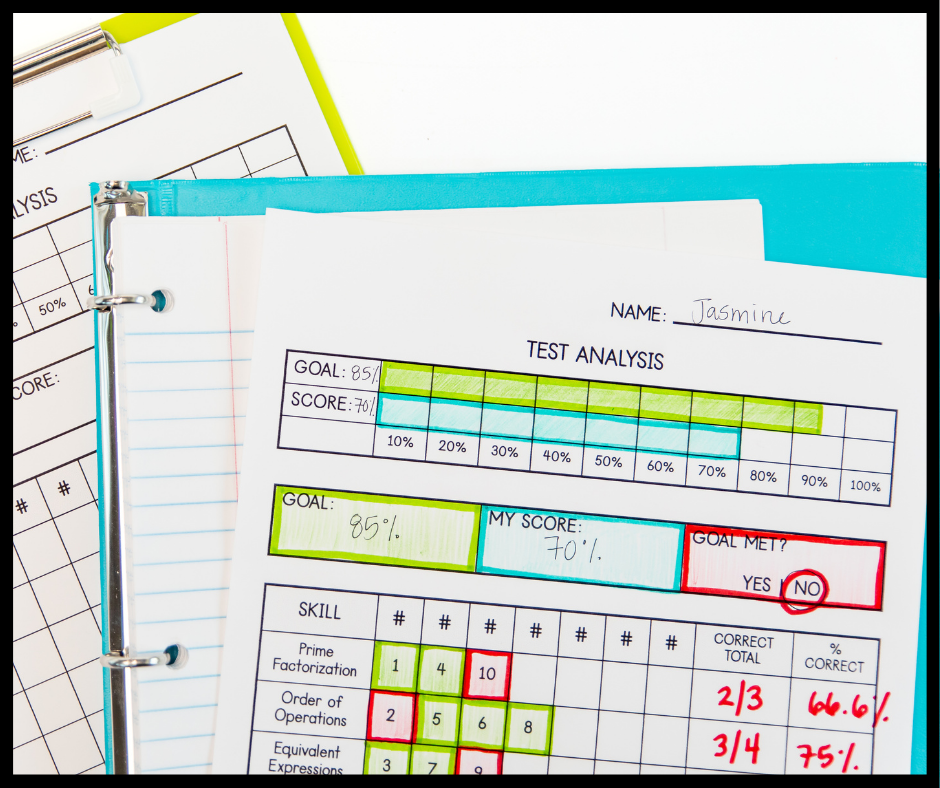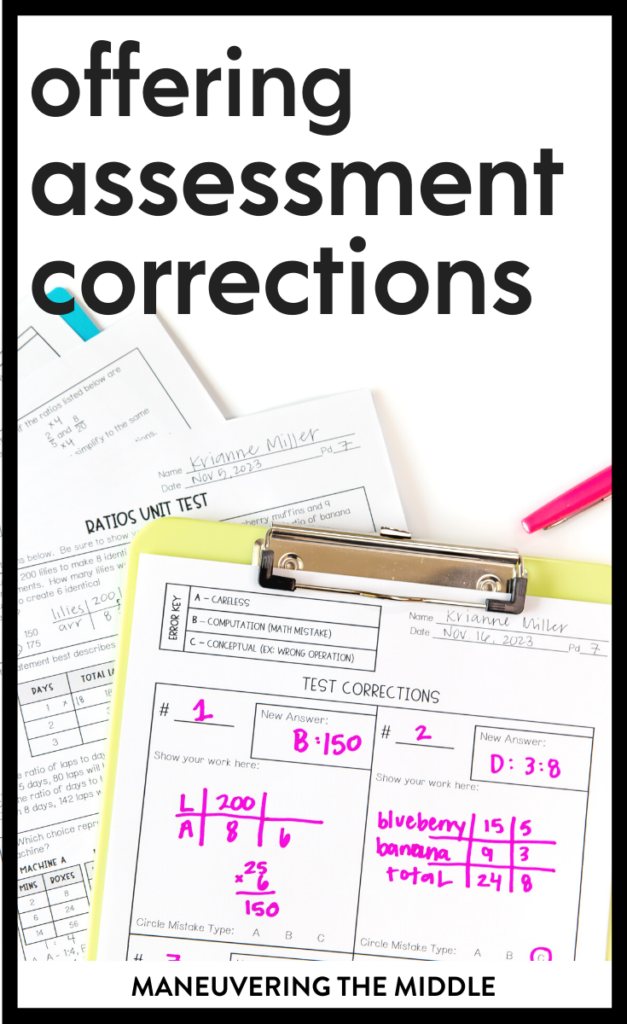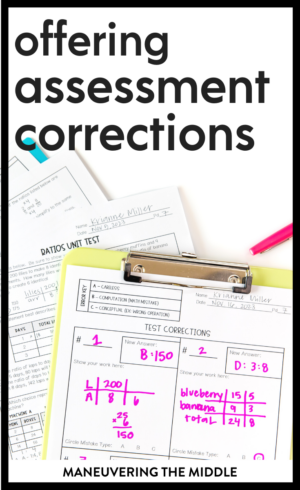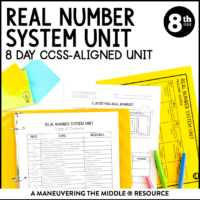Teaching students to do test corrections doesn’t have to be time consuming or result in a paper pile! Test corrections are actually one of my favorite tools for pushing students and measuring their progress.
Giving math tests can be equally rewarding and frustrating. As a teacher, you can see what skills your students really understood and what skills you thought your students understood.
I try to remind myself that the test is not the end goal. My students’ learning and preparedness for the next grade level is the end goal. So what do you do when you have students who bomb a unit test?

Test Corrections vs. Retaking the Test
Test corrections have to happen before students retake a test. I have fallen into the trap of allowing students retake a test only for them to do the exact same or worse.
If they didn’t master the material the first time, they will not master it the second time unless you provide additional tutoring and practice. I actually do not provide retake opportunities – I know my limitations and managing retakes is not for me. Instead, shortly after students have taken a test, I offer test corrections as an in-class assignment.
My school uses a website (Illuminate) that allows me to see what percent of students mastered each skill, and it allows me to see what percent of students answered each question correctly. I use this information to guide my teaching as I decide which questions I need to go over with the entire class.
If a majority of my students miss question 10, then maybe I need to go over it and make sure students practice that type of problem on future warm-ups. If a majority of my students miss most of the problems related to a specific skill, then perhaps I need to reteach that skill. (My benchmark is 80% of students will master a skill at around 80% – this post explains this in more detail.)
Model How to Correct Test Questions
Similar to how you would model solving a problem, model how you would like students to complete their test corrections. When you model how you would like students to correct their test questions, you will receive far superior results or work. When I go over the most missed problem with my whole class, I provide an anonymous incorrect student example for the class to discuss the error that was made.
I then model exactly how their corrections should look to avoid many students just circling another answer choice and writing down that the mistake they made was that they guessed. I utilize the handful of 100s as student teachers, so they can help their classmates.
Grab this free Test Corrections Printable here!

Utilizing a skill Analysis
I shared about utilizing test analysis and reflection in this post. But, before we correct our tests, I have students complete a test analysis.

I categorize each test question into the skill that it covers, and students color in the test question box based on whether they got it correct or incorrect. It provides a visual for students and the teacher to see which skill they need to work on. Students save the skills in which they did the best for independent practice.
For the group work portion of class, they can utilize a partner or a student teacher for help on the skills that they missed a significant amount of problems.
Additionally, I think that it is important for students to set goals and analyze why they missed problems on a test. The test corrections printable has been updated to include a few reflection questions.
- Did they make calculation errors?
- Did they solve using the wrong operation?
- Are they studying?
- Are they paying attention in class?
- Are they asking questions when they don’t understand?
If you do allow retakes, then you are going to need to make additional tests. If you want that work done for you, try All Access. (All Access is a standards-based curriculum that includes everything you need to teach middle school math + editable unit tests + additional versions of tests perfect for retakes).
Reassessing the same skills
Like I said before, I don’t offer retake opportunities. I will give points back on their test for quality corrections and reflections. You might think that fosters an environment where students don’t really care about doing well on tests and won’t study.
However, in my experience, students who really need points for a better grade are not students who will try harder next time if they fail this time. They will be disappointed in their grade and their progress in math mastery will dissipate as they have not been successful.
I do, however, like to continue spiraling through material that we have learned in the past. I remind students that they will see similar test questions on future tests or quizzes.
This will help me make sure students are retaining what they have learned, and allows me to see if students who did not previously master a skill were able to after corrections and additional practice.
When I was in school, tests were all about grades and making my parents proud. Now as a teacher, I have a completely different outlook of what tests should and shouldn’t be.
How do students complete test corrections in your classroom?

Maneuvering the Middle has been publishing blog posts since 2014. This post was originally published in December 2016. It has been updated for relevance and clarity.







Like you, I love test corrections. Out of curiosity do you provide students credit back for completing test corrections – if so, partial or whole? I offer full credit back, but I have them doing extra work to earn their credit back, in comparison. For me, they show the correct way to solve the problem, like your form does, but they also have to explicitly state how to solve the problem. I tell that I should be able to hide their work and be able to follow their written instructions and reproduce the work exactly. What I would love to add is your item analysis along with it. I’m going to have to think about how to do that.
Great idea, thank you for sharing! Yes, I offered half-points back.
I love this idea. Full points for providing the correct work as well as a detailed explanation. Half points for just the correct work. Definitely need to model what I am looking for as the article said.
Maybe I will say you may get half to full points back based on your detailed test correction.
Yes! Thanks for your comment!
Nice but my teachers let us do test corrections if we get a bad grade on the test if we get a 40 out of one hundred she subtracts 40 by 100 which is 60 and 60 divided by 2 which is 30 and 30 plus your original grade just by correcting your wring answers on the test and explaining why, that is the answer and writing a 5 to 8 sentence why test correction are important.
Hi. I think test correction is a valuable tool for mastery. Do you allow all students to correct for 1/2 points or only those who got low grades?
I allow any students who will make the effort.
This may be a good practice for Jr high but I prefer quiz corrections for high school. High school students learn to depend on corrections for passing tests. I don’t think that finding your mistakes should wait until you take a class so I offer quiz corrections and then retesting. I review constantly to give them the opportunity to learn the material.
Hi Stacey! It sounds like you have a great system for your high school students. Thanks so much for sharing!
I return quizzes without grades with the mistake highlighted. I give kids 10 minutes of no talking to see if they can figure out their mistake. I have an extension activity for my 100% kids, who I use as “teachers” in phase two. After the 10 minute, I allow for help but only in the form of a question. I don t want kids to just correct however learn from the mistake. Usually this is enough to make corrections then the quizzes are returned to me. I have a form that students fill out that is reflective of the error.
I love this idea! Thank you for sharing!
I will try this with my students.
My school uses Illuminate for interim testing, so I have access to it. Do you add your test questions (from your curriculum on TpT) to Illuminate, do a bubble fill in sheet along side a paper test or do you use item bank questions from Illuminate? I am a first year teacher who is looking to make my data collecting easier and more sofisticated. Any more tips will be greatly appreciated. Thanks for all you do.
Hi, Jessica! Sadly, our curriculum is not in Illuminate. However, you can create a bubble sheets pretty simply from the answer keys. We are planning on addressing data collection in a future post, so stay tuned. Thanks!
I’m a parent of a middle schooler. I am curious if your students are allowed to take their graded tests home? My child is not allowed to take the test home. If I want to see the test I have to go in during the teacher’s prep time.
Yes! My district is pretty strict about tests not leaving the classroom too. I only allowed quizzes to be sent home.
My school is using illuminate this year. I like to offer test corrections in lieu of retesting. How do the students access their tests after they have taken them?
Thanks, I am still knew to Illuminate.
Hi! I am definitely still an illuminate novice, but I wouldn’t use Illuminate for the corrections grading piece. I only used Illuminate for students to see which problems they need to correct. For example, I would go to ‘reports’ and then access ‘student small slips.’ I would make sure the small slip included which problems were incorrect but not give them the correct answer. Hope that helps!
Hey! We just started using Illuminate this year and I have not found a good way to do retakes or test corrections. How do you do this?
Thanks!
Unfortunately, I get to see the disaster of test corrections at my high school. Students who have learned they need to study and retain nothing because they can get half their points back. Just enough to get by. We’re just getting them through – completely unprepared for work or college – they don’t prepare, they don’t put much effort into anything except corrections.
I’ve heard every reason test corrections are a good thing – I’ve yet to see any positive come from it, at least long term.
No work ethic, no memory, “just get ’em through”.
Hi, Eric! I think that teachers can require test corrections, but make them an assignment that does not give them points back on their test – maybe a homework grade. I think it is always beneficial for students to access their errors, but I do agree that if students learn that they can blow off a test only to bring their grade up easily later, then we have done a disservice.
How much time do you give your students to complete the quiz correction? How often do you give quiz in your class and how long?
I don’t have a perfect answer for this. I would give a 5 question quiz about once a week. Depending on the problem types, it might take 10 minutes or it could take 30 minutes. Same with corrections. Some kids have 1 problem to fix and others have 5, so it helps to have some extension work on hand for early finishers.